Serial Number 1400

As usual, you can click on any image to see the high-resolution version.
The pdp-10 was the pre-VAX large system. It was octal, a 36-bit machine,
and went through various incarnations between 1965 and (I think) 1983,
when development finally stopped. Operating systems, TOPS-10 and TOPS-20,
were wonderful pieces of s/w engineering, seeing the first implementation
of ideas now in common use in o/s and network architecture. If you want
to experience them firsthand, visit http://www.corestore.org/tops.html - warning, it's a large download (which will take a minute or two even
on broadband) and it's a Java applet which will ask for permissions; it
IS kosher!
If you're going to be a wimp and run an emulated KL instead of the real
thing, you might as well use an appropriate terminal to bring it up :-)
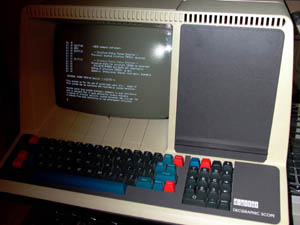
My system is a KL10, the most powerful example of this architecture. This
particular machine is one processor from a triple-cpu configuration that
I rescued from British Airways at Heathrow, London, where it was in use
until 1992. I understand it was running British Airways logistics &
planning systems. As far as I know, it was the second last DEC 10/20 machine
running in the UK - the last machine was the 2020 at Robert Gordons, which
I also rescued.
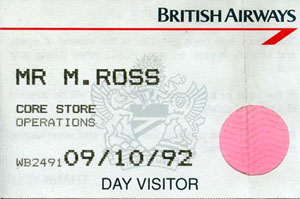
It's incomplete, as I wasn't allowed to remove the memory; the system had
already been assessed by the scrap merchants, and their verdict was that
the memory was particularly gold-rich. They didn't mind if a CPU went missing,
but they had *counted* all the memory cabinets! (it was Ampex, not DEC).
Also, the I/O cabinet, where the RH controllers, memory interface etc.
live was unfortunately lost (along with a 2020) when the premises I was
storing them in was flooded due to a burst pipe upstairs; the DEC stuff
wasn't significantly damaged, but the house above the garage where it was
stored (belonged to my boss at the time) was unoccupied for an extended
period, so the leak did very considerable damage there - the interior of
the house had to be virtually demolished. The builders cleared the garage
before I had a chance to rescue my stuff :-(
This is the CPU on an old polaroid, shortly after I rescued it. pdp-8/L
in the next rack... as always, you can click on any image to see the high-resolution
version in a new window.
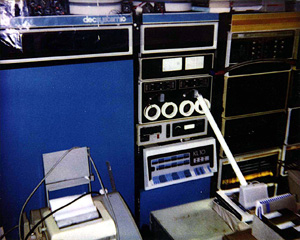
What I do have is the complete CPU box and the console processor - a specially
configured pdp-11/40 - complete with dectape and power control. I also
managed to get hold of a set of diagnostic and RSX dectapes for the console,
and a fairly complete set of prints and manuals. A more recent image...
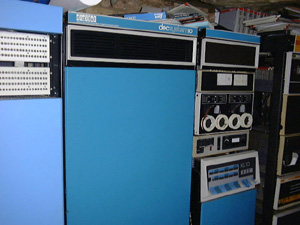
pdp-15 FPU on the left... a useful illustration of the difference between
'18-bit blue' and '36-bit blue'!
OK let's take a look inside... inside the front, behind the big blue door
in the above image, is the CPU backplane:
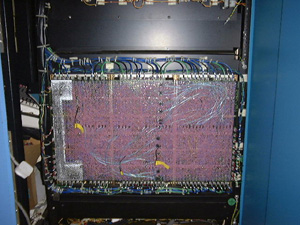
A rats nets, with some seriously heavy-duty power supply wiring. It's an
ECL beast, remember.
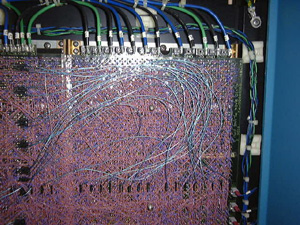
Close-up of part of the backplane...
Round the back of the chassis, there's another big blue door which leads
to the 'business end' of the beast:
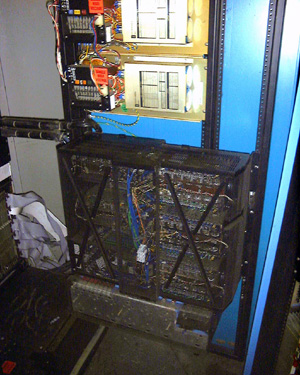
Opening the door, on the back of the door, the infamous 'series-pass' assembly
- part of the power supply.
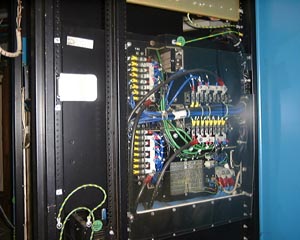
View of the other side of the series-pass assembly.
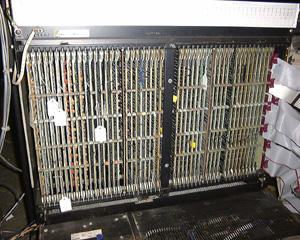
In front, the CPU - door removed to show a large collection of boards,
all ECL.
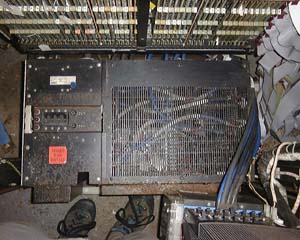
Looking down, the three-phase transformer - the first stage of the power
supply. Showing slight corrosion on top, but easily cleaned up. You would
not *believe* what this whole cabinet weighs... half the weight is this
transformer I think. An unofficial field modification done on quite a few
KL machines was to throw away the entire DEC power supply and replace it
with a modern switched-mode PSU. This could slash power consumption by
up to 1/3!!!
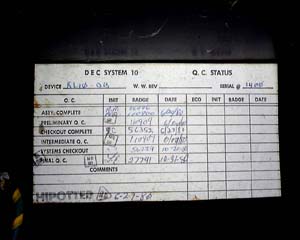
In the top of the CPU cabinet is the serial number plate, and the QC sticker
- which shows that the system received its final checkout before shipping
on 10/31/80.
OK now for the front-end... a standard H960 19" rack, which lives
next to the KL10-D CPU rack. It contains:
The front-end pdp-11/40 system, used to boot the KL, load microcode, run diagnostics etc.
The power distribution/control unit - a little like an 861 power control
on steroids!
The system control panel - usual switches, load device, EPO, status lights,
and margin check panel for the KL.
The front-end boot device - could be DECtapes or RX02 8" floppy.
The DECtape controller (TC11), if DECtape was fitted.
Some Unibus peripherals were also interfaced through it. Ran a special version of RSX.
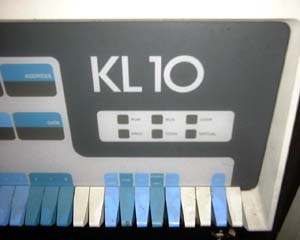
Closeup of the KL logo on the front-end.

Control panel and TU56 DECtapes.
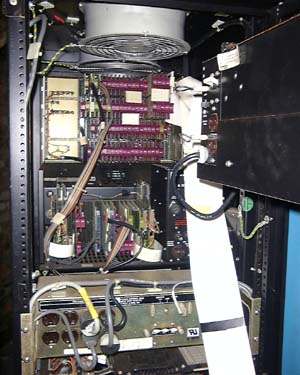
Looking in the rear of the front-end rack: the top of the 11/40 chassis
is at the bottom of the picture. In the middle, the TU56 DECtape drive,
in the top is the TC11, the Unibus DECtape controller. The power supply
in the top right, in the back of the door, supplies the TC11/DECtape combination.
There are a LOT of -10 enthusiasts out there, despite the size of the beasts...
http://starfish.osfn.org/rcs/DECsystem/1090/ the RCSRI have a beautiful one!
http://pdp10.paulallen.com/ Paul Allen is rumored to have one, or be interested in one, but he presently runs a Toad...
http://www.stupi.se/Bilder/pdp-10/index.html makes me (and most other computer preservationists I suspect) look like a complete amateur!
http://www.brouhaha.com/~eric/retrocomputing/pdp-10/ Eric Smith has one...
http://www.shiresoft.com/pdp-11/kl-10 ...so does Guy Sotomayor...
starfish.rcsri.org/rcs/DECsystem/FAQ/Serial_Number_Master.pdf is a list of all known systems
http://www.aracnet.com/~healyzh/pdp10emu.html quite a few people are running 10s in emulation